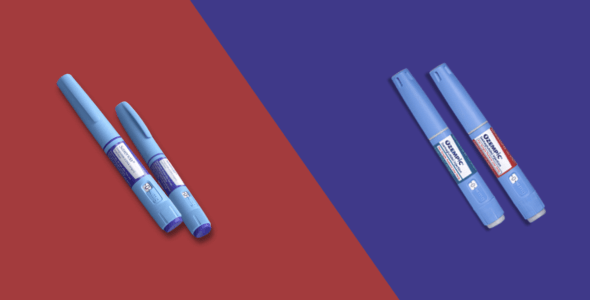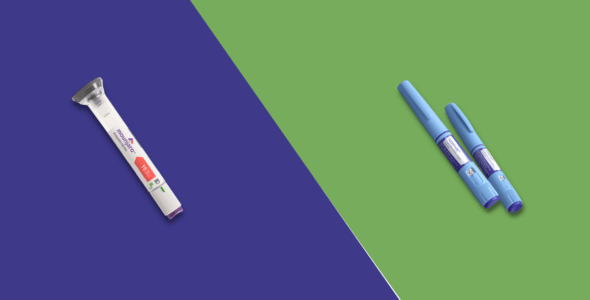Wegovy and Saxenda are brand name FDA approved (U.S. Food and Drug Administration) weight loss medications. Both drugs are manufactured by Novo Nordisk and are glucagon-like peptide-1 receptor agonist medications. This class of medication has been used to treat diabetes and now is available for weight loss. Wegovy is a weekly injection that contains semaglutide and Saxenda is a daily injection that contains liraglutide. Read on to find out about the similarities and differences between Wegovy and Saxenda.
What is Wegovy?
Wegovy is a higher-dose, 2.4 mg version of the diabetes drug Ozempic (lower dose injection) and oral diabetes drug Rybelsus containing semaglutide.
It is a glucagon-like peptide-1 (GLP-1) receptor agonist indicated as an adjunct to a reduced-calorie diet and increased physical activity for chronic weight management in adult patients with a body mass index (BMI):
- 30 kg/m2 or greater (obesity)
- 27 kg/m2 or greater (overweight) in the presence of at least one weight-related comorbidity condition such as hypertension, type 2 diabetes mellitus, or dyslipidemia
Wegovy should not be used in combination with other semaglutide-containing products or any other GLP-1 receptor agonist. The safety and efficacy of use with other products for weight loss have not been established. Also, Wegovy has not been studied in patients with a history of pancreatitis.
What is Saxenda?
Saxenda contains the prescription medicine liraglutide. Saxenda is recommended alongside a reduced-calorie diet and an increase in physical activity. It is used to manage body weight loss and obesity in adult patients with a body mass index (BMI) of
- 30 kg/m2 or more, or
- 27 kg/m2 or more, if you have high blood pressure, type 2 diabetes, high cholesterol, triglycerides, or a low HDL cholesterol level that is making plaque build up in your arteries worse
Saxenda is also approved to
- Treat obesity in children ages 12 and older. To qualify, children must weigh at least 60 kg (132 pounds) and have a starting BMI of 30 kg/m2 or greater.
Saxenda is not specifically for the treatment of type 1 or type 2 diabetes or weight loss. Saxenda is part of a treatment plan that will include, diet, exercise, and weight management. The brand name drug Victoza contains the same active ingredient as Saxenda but is used for the treatment of type 2 diabetes. The difference is in the dosage.
How do Wegovy and Saxenda work?
Let’s look at GLP-1 receptor agonists to understand how these drugs work. They belong to a drug class called GLP-1 (glucagon-like peptide-1) receptor agonists. When you eat and drink, your body produces digestive hormones called incretins. GLP-1 is one of these incretin hormones.
GLP-1 incretin hormones help lower your blood glucose levels when you digest food in three ways. They:
- Stimulate your body to produce more insulin
- Prevent the release of glucagon
- Slow down how quickly your body digests food
The active ingredients in Wegovy and Saxenda act in the same way as GLP-1 incretin hormones. By stimulating the same receptors, they cause your body to release more insulin, less glucagon, and digest food slower.
GLP-1 is classed as a physiological regulator of appetite and calorie intake. This means it works by a method known as negative feedback. The GLP-1 receptor is seen in several areas of the brain involved in appetite regulation.
What doses of Wegovy are available?
Wegovy is available in a prefilled injection form, in the following doses: 0.25 mg, 0.5 mg, 1 mg, 1.7 mg, or 2.4 mg.
Wegovy should be used once weekly, on the same day each week, at any time of day, with or without meals. Inject subcutaneously in the abdomen, thigh, or upper arm.
Start at 0.25 mg once weekly for 4 weeks. Increasing the dose 4 weekly until a dose of 2.4 mg is reached. The maintenance dose of Wegovy is 2.4 mg once weekly.
If you miss your weekly dose of Wegovy and there are less than 3 days until your next dose, do not take the missed dose. The Wegovy injection can be stored at room temperature or in the refrigerator.
See the full prescribing information for the complete boxed warning. You are recommended to read the medication guide and advised to always speak with your healthcare provider about any changes to your dose so they can monitor and evaluate your condition.
What doses of Saxenda are available?
Saxenda is available as a pre-filled pen that delivers doses of 0.6 mg, 1.2 mg, 1.8 mg, 2.4 mg, or 3 mg. Dosing starts at 0.6 mg daily, and over four weeks is increased to the full dose of 3 mg.
Saxenda is given daily as a subcutaneous injection in the abdomen, thigh, or upper arm. It can be given at any time of the day, with or without a meal. You should not inject into the same place two times in a row. If the injection has particles in it or has changed color, do not use it.
You should dispose of used needles and syringes by using puncture-proof disposal sharps container. Store unopened pens in the refrigerator. In-use pens may be kept at room temperature for up to 30 days. Always remember to store your medicine out of reach of children and pets.
Is Wegovy more effective than Saxenda in weight loss?
Wegovy injections have actually been found to be more effective for weight loss than Saxenda.
A 2018 study carried out over a year compared weight loss with semaglutide injections, liraglutide injections, and placebo. Participants either received daily doses of semaglutide, liraglutide, or a placebo injection. Semaglutide was given in daily doses rather than weekly doses in this trial. At week 52, average weight loss with those given semaglutide injections was 11.2-13.8% of their starting weight, whereas liraglutide participants lost around 7-8%.
It is important to know that this shouldn’t be your only deciding factor when you’re choosing between medications. The final decision on your treatment is down to your prescriber alongside a discussion with you. Both medicines work in a very similar way within the body, but you should seek medical advice from your healthcare professional about which of these weight loss drugs would be best for you based on your medical conditions and your current medication including any over-the-counter meds and supplements.
Why is there a difference in frequency of injection?
This is due to differences in the elimination half-life of the drugs. Saxenda has an elimination half-life of approximately 13 hours, making liraglutide suitable for once-daily administration. Wegovy injections have a 7-day elimination half-life, allowing it to be administered once weekly instead.
Black boxed warnings of Wegovy and Saxenda
Semaglutide and liraglutide cause thyroid C-cell tumors in rodents at clinically relevant levels. It is not known if Wegovy and Saxenda cause thyroid C-cell tumors, including medullary thyroid carcinoma (MTC), a type of thyroid cancer in humans as the human relevance of semaglutide-induced rodent thyroid C-cell tumors has not been determined.
Wegovy and Saxenda are not recommended in patients with a personal or family history of MTC or in patients with multiple endocrine neoplasia syndrome type 2. It is important to know of the potential risk of MTC and symptoms of thyroid tumors.
Side effects of Wegovy and Saxenda
The most common side effects of Wegovy and Saxenda in clinical trials compared to placebo include:
- Nausea, vomiting
- Diarrhea, constipation, abdominal pain
- Headache, dizziness
- Fatigue
- Dyspepsia, abdominal distension, eructation
- Hypoglycemia (low blood sugar) in patients with type 2 diabetes
- Flatulence, gastroenteritis, and gastroesophageal reflux disease (heartburn)
In rare instances, Wegovy can cause more serious side effects. These can include:
- Thyroid C-cell tumors
- Acute pancreatitis
- Acute gallbladder problems
- Hypoglycemia (very low blood sugar levels) – feeling very weak, shaking, confused, sweating, fainting, or seizures
- Acute kidney injury – monitor renal function when initiating or escalating doses if severe adverse gastrointestinal reactions occur
- Hypersensitivity
- Diabetic retinopathy complications in patients with type 2 diabetes
- Heart rate increase
- Suicidal behavior and ideation
Your doctor will assess the benefits of using Wegovy against your risk of side effects. Patients are encouraged to report negative side effects or adverse reactions of Wegovy to the FDA. Visit www.fda.gov/medwatch, or call 1-800-FDA-1088.
Wegovy and Saxenda drug interactions
Wegovy and Saxenda cause a delay in stomach emptying and thereby have the potential to impact the absorption of concomitantly administered oral medications.
Wegovy and Saxenda can interact with other medications. These include:
- Bexarotene – cancer treatment
- Gatifloxacin – an antibiotic
- Insulin – aspart, detemir, glargine, lispro
- Oral diabetes medicines – glipizide, glimepiride
- Antiviral medication – amprenavir, atazanavir, darunavir, ritonavir, saquinavir
- Diuretics – bendroflumethaizide, bumetanide, furosemide
- Antibiotics – ciprofloxacin, clarithromycin, norfloxacin
- Corticosteroids – dexamethasone, fludrocortisone, prednisolone
This list is not exhaustive and other drugs may interact with Wegovy and Saxenda.
Wegovy and Saxenda warning and precautions
You should not use Wegovy or Saxenda if you:
- Are allergic to the active ingredients liraglutide or semaglutide
- Are allergic to any of the other ingredients in Wegovy or Saxenda
- Are using insulin or albiglutide, dulaglutide, or exenatide
- Have multiple endocrine neoplasia type 2
- Have a family history of medullary thyroid carcinoma
- Have diabetic ketoacidosis
- Are under 18 years of age
Talk to your doctor before using Wegovy or Saxenda if you:
- Are taking any of the medications that could interact with Wegovy or Saxenda
- Have kidney disease
- Have liver disease
- Have high cholesterol or triglycerides
- Have heart problems
- Have problems with your pancreas or gallbladder
- Have depression or suicidal thoughts
- Have stomach or digestion problems
- Are pregnant or are planning to become pregnant
- Are breastfeeding or are planning to breastfeed





